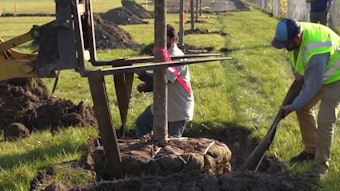
The lawn renovation business is poised to rebound for the next several years. If you're one of the roughly 42,000 contractors looking to grow this line of business—or one of the thousands looking to break into it—here are some things you'll want to know as you establish your plan of attack.
It's a diverse, competitive market
Over the past five years, contractors have entered the lawn renovation business in droves. But according to Scott Kinkead, executive vice president of equipment maker Turfco, there is plenty of room for more.
"It's always about being competitive," Kinkead says. "For contractors already in this business, it's going to be about keeping existing customers and expanding services, whether it's aerating, seeding or using a sod cutter.
"There's also room for more contractors," Kinkead continues. "It's all about how they are selling their services. Like anything, they need to promote the benefits and value of lawn renovation. Just going out there and telling people they offer the service doesn't mean they'll grow their business. They need to be an educator and explain the value of a turf maintenance program—which leads to long-term relationships."
Getting started
For contractors just starting out in lawn renovation, Pierre Pereira says it's a good idea to work with a local equipment dealer to not only get equipped, but to become educated.
Dealers can often help you get your hands on educational materials for marketing pieces. "Start marketing as soon as possible," Pereira advises. "Differentiate your offering. Get in front of the season so you can glean target audience mind space." Pereira is vice president of sales and marketing at equipment manufacturer Billy Goat Industries.
"Start out small and make customer service your top priority," offers Jay Baudhuin, product manager for the Classen and Ryan brands. "Remember, it will take some time to build your customer base—so be patient. Outline a marketing plan; Yellow Pages, door hangers and yard signs are some options."
Identifying who your customers are is another critical first step. "Are you after commercial, residential, or a combination?" asks Kinkead.
If you're thinking about becoming a lawn renovation specialist, get to know the contractors in your area that do not offer these services. Then, get a good business model in place. "Provide quality and productivity so it appears as seamless as possible for the end customer," Kinkead explains. "Also, figure out how it's going to be profitable for both you and the primary contractor—and find out expectations and timeline."
Building your business
In the residential maintenance arena, which contractor gets the business often comes down to who markets and sells the best, according to contractor Jeff Roth, fleet manager for Bluegrass Lawncare in Bridgeton, MO.
"We market lawn renovation all year round, generally building it into our overall seven-step lawn care program," Roth says. "We also do a rigorous marketing effort directed toward our existing customer base that starts in the middle of the summer. Then, in August, we ramp up and do another campaign to add new customers just for fall aeration and seeding."
In the commercial maintenance business, it's a good idea to make lawn renovation a component of an overall maintenance package. However, you may want to consider keeping it out of the contract. Why? Because putting lawn renovation services in your bid could result in your over-bidding.
"We keep lawn renovation services separate so they're treated as add-ons," says Tom Del Conte of Del Conte's Landscaping in Fremont, CA. "That way we can control it better. The customer sees what we're doing, and nothing is taken for granted.
"That's not to say that we aren't talking about lawn renovation early in the sales process, because doing so is very important," Del Conte adds. "Selling a la carte, though, positions us as the expert."
Since services like dethatching and aerating are harder for the consumer to understand, Del Conte has found that incorporating visual aids in the sales process is effective. Photos showing aeration cores or the amount of thatch that's typically raked from a lawn can make an impact. So do graphics or illustrations explaining the positive effects of these services on overall turf health. "You should be able to get some of these items from your dealer," Del Conte reminds.
Look at additional markets you could penetrate. For instance, if you're in the commercial maintenance business, could you target segments of the residential market?
"Municipalities, golf courses and sports complexes are other potential customers," Baudhuin points out. "With budget cuts, municipalities are looking to outsource certain functions to the private sector." The same goes for golf courses and sports complexes. If any of these niche markets present real opportunity, you'll need to think about buying larger equipment, such as mower- or tractor-mounted implements. Renting is also an option if you have just a handful of larger jobs.
Finally, look at additional services you could incorporate into your lawn renovation offering. Dethatching, aeration and overseeding are the most common. But contractors located in the mid-section of the country, such as Del Conte, have found additional revenue in the way of verticutting and re-seeding.
"I'm located in the Bay Area of California, and we have these large patches where warm-season grasses such as Bermuda and St. Augustine have invaded and dominated, because they are very aggressive in nature," Del Conte explains. "Many property owners do not want this because these grasses go dormant and brown in the winter. We've created a nice business of verticutting and overseeding with cool-season grasses in the fall."





























